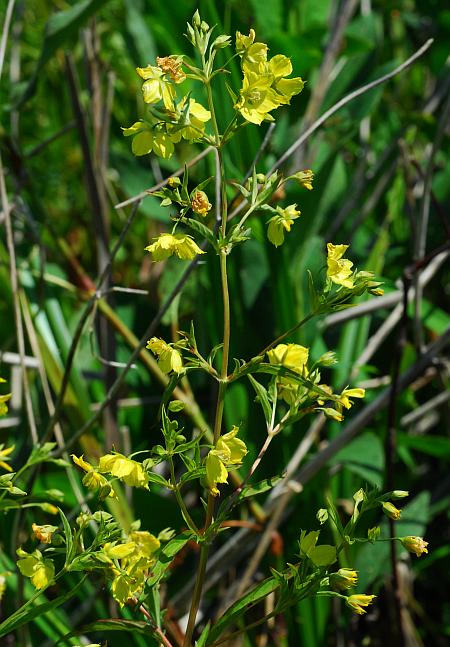Lysimachia hybrida Michx.
Lowland Yellow Loosestrife

Native
CC = 7
CW = -5
MOC = 32
© SRTurner
Lysimachia hybrida Michx.Lowland Yellow Loosestrife | |
 |
Native CC = 7 CW = -5 MOC = 32 |
© SRTurner |
|
Family - Primulaceae Habit - Perennial forb with short, stout rhizomes. Stem - Strongly ascending to erect, to 80 cm, relatively stout (2-6 mm in diameter at the base), usually branched above the midpoint, glabrous or minutely glandular-hairy toward the tip, especially near the nodes.
Leaves - Opposite, simple, petiolate. Basal leaves rarely persistent at flowering. Lowermost stem leaves usually with a relatively well-defined petiole 0.5-1.5 cm long, these progressively shorter and less well-defined toward the stem tip, the uppermost leaves often appearing essentially sessile, when present, the petiole somewhat flattened, narrowly winged, the margins pubescent with long, spreading hairs below the midpoint, the pubescence sparse or absent toward the tip. Leaf blades 3-12 cm long, 1.0-2.5 cm wide, those of the lowermost leaves ovate to lanceolate, becoming progressively narrower toward the stem tip, the uppermost leaf blades often linear to narrowly lanceolate, the bases accordingly rounded to angled or tapered, angled or somewhat tapered to a sharply pointed tip, the margins entire or more commonly roughened with minute papillae, the surfaces lacking gland dots, not punctate, green, glabrous; secondary veins evident.
Inflorescences - Solitary flowers axillary from the uppermost nodes, the stalks 1-4 cm long, glabrous.
Flowers - Calyces mostly 5-lobed, the lobes 4-6 mm long, lanceolate, not gland-dotted or punctate, usually with 1-3 evident veins. Corollas mostly 5-lobed, the lobes 5-10 mm long, obovate to broadly obovate, broadly rounded but usually apiculate, the margins sometimes somewhat uneven or irregularly toothed, yellow, densely glandular and with reddish markings on the upper surface toward the base, lacking purple spots or lines. Stamens 5, shorter than the corollas, the filaments 2-3 mm long, not fused into a basal tube, glandular-hairy. Staminodes alternating with the stamens, slender. Styles 3-4 mm long. Ovary superior, with few to many ovules, the style slender, the stigma capitate. Fruits - Capsules 3.5-5.0 mm long, broadly ovoid to globose. Seeds 1.2-1.8 mm long, irregularly elliptic, oblong, or rhombic in outline, triangular in cross-section, dark brown to black.
Flowering - May - September. Habitat - Pond margins, swamps, fens, streambanks, bottomland forests, bottomland prairies, pastures, railroads, roadsides, moist disturbed areas. Origin - Native to the U.S. Lookalikes - Several other species of Lysimachia, especially L. ciliata and L. lanceolata. Other info. - This showy species is found in scattered locations in Missouri, these areas lacking a well defined geographical pattern. Its U.S. distribution is likewise scattered but mainly concentrated in the upper Midwest. The plant is easily identified as belonging to the Lysimachia genus by its yellow flowers having glandular, reddish bases and, usually, small points at the ends of the petals. However, differentiation of this species from its close lookalikes can be difficult. An important character is the leaf petiole, which has stout hairs near the base but fewer or no hairs near the leaf blade. The plant also has rhizomes which are very short, rarely reaching 5 cm, but this unfortunately requires uprooting the plant to observe. The stems are somewhat more robust, and the habitat preference generally wetter, than the corresponding traits of L. lanceolata. Photographs taken at Rose Pond Conservation Area, Clark County, MO, 7-9-2017 (SRTurner). |